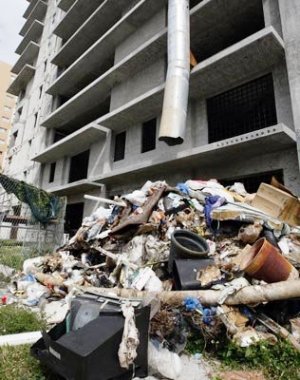Here are a few of
the stalled projects: Brickell
Sunview/Aloft Hotel Despite being sold
for $11.5 million in 2010 and repurposed by a top-tier hotelier earlier this
year, the project has been stuck in shell-mode for more than two years. The piles of trash
and graffiti scrawled on the walls have become a drag on a neighborhood
hoping to benefit from Brickell’s revival, said Robert Lechter, who
represents the owner of Brickell Station Lofts, an apartment complex across
the street from the construction site. “There should be
some kind of a law against that,” he said. “We purchased Brickell
Station Lofts two years ago and that building was exactly the same way it is
now.” In January,
Starwood Hotels announced that it would be building a 160-unit Aloft hotel
on the site, complete with an indoor pool, a swanky bar and meeting spaces.
It was supposed to open in December, but the company has pushed the launch
date back at least twice. Its website has updated the opening date to July
2012, but that date seems unlikely. The project is expected to need about
eight months to complete construction, and there are no active cranes or
machinery on the site. Starwood hotels did not return calls seeking comment. “I can’t
believe that someone would invest that kind of money and just leave it like
that,” said Lechter. “It does have an impact on the area because a third
of Brickell Station Lofts looks out on that building. That’s not fun.” Logik
I Only about four of
Logik I’s 30 stories were built before the construction crane lowered its
neck and drove away nearly four years ago. Supported by The proposed
office condo was planned for about 350,000 square feet of offices for small
companies and retail space that could host a restaurant or boutique. In the months
before the real estate bubble burst, developer Jorge Arevalo of Miami-based
Urbana Development rushed to gain city approvals and kickstart construction,
announcing that sales were so strong that he was planning to build a second
30-story tower for the site. Not long after,
the real estate downturn hit, and the project tanked. “We got it
approved and what happened is the real estate opportunities went away and
the market went away,” said Lucia Dougherty, an attorney who represented
Urbana Development. Dougherty said she lost touch with the developer after
the project stalled. Arevalo could not be reached for comment. The project was
sidelined by legal and financial troubles, with the developer filing a $90
million lawsuit against Bank of America in 2008, alleging the bank refused
to provide $39.5 million in promised financing. As financing dried up,
several subcontractors placed millions of dollars worth of liens on the
property for unpaid wages. Hallandale-based
Mustang Electronics bought the shell building last year out of foreclosure
and has not done much to the squalid site since then. It is hoping to sell
the land under the building for a profit. There are a few “For Sale”
signs hanging on a forlorn fence, and debris litters the site. Mustang
Electronics declined to comment about the site. Filling
Station Lofts The legal battle
over Filling Station Lofts, The original
developer, Daniel Holtz, had planned a 17-story, 100-unit luxury condo
building back in 2006. Part of Now, three years
after construction financing dried up, the graffiti-stained structure and
the weeds sprouting around it are having the opposite effect. The building
is flanked by shuttered storefronts and barren land, as few businesses have
been willing to open next to the dilapidated 17-story shell. Its owner owes
more than $30,000 in overdue property taxes, according to county records. “A lot of these
projects become shelter for the homeless or squatters because they have sat
without any maintenance now for three to five years,” said McCabe. “In
some cases, they have been open to the elements, and there has been
deterioration of the properties.” The project could
face years of litigation as several subcontractors allege the developer
conspired with an investor group to stiff them of more than $3.5 million in
wages. There are several lawsuits pending. “They hurried us
along, made us finish, then told us there was no money left,” Ronald
Laing, president of Biscayne Roofing and Waterproofing Systems, said in an
interview with The Miami Herald earlier this year. He said his company put
the roof on the condo building, completing $225,000 worth of work in 2008
without being paid. An attorney for Holtz did not return calls
seeking comment. |
